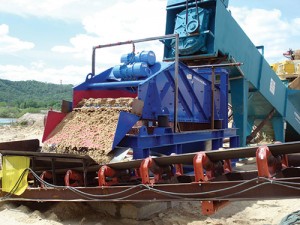Author
Back to basics: Choosing a screen
Taking a look at horizontal versus inclined screens, as well as the effects of screening motion. Screens are used throughout the aggregate processing flow to separate and size material prior to and following crushing stages. While most producers are aware of the overall process, following is refresher on the types and effects of screen angles and motion. At the primary stage, large scalping screens remove fine material before the feed enters the primary crusher, helping to protect the crusher’s wear parts from abrasive stone or sand material that has already been sized. Without scalping, the primary crusher’s liners wear down faster, requiring more frequent changes and maintenance downtime. Following the primary crushing stage, screens with two or three decks and different opening sizes are used to separate the aggregate material into different size categories – with conveyors transporting the sized material for further crushing or for stockpiling as a saleable product. Usually this screening is accomplished through dry screens. Wet screens may help to remove debris from material before stockpiling,… Keep Reading
Cleaning up
One New Jersey sand-and-gravel company moves more inventory thanks to a material washing system. Dun-Rite Sand and Gravel had a big problem — one that weighed approximately 15,000 tons at the beginning of 2013, and was getting bigger by the day. The company was taking clay, gravel and sand from the man-made pond at its Vineland, N.J., location with a 14-in. Marlin dredge and pumping it to the surface. It screened and sorted materials, then put them through a coarse material washer. From there, the sand went into twin classifying tanks, where it was re-blended to meet certain specifications. Dun-Rite sold the materials primarily for concrete sand, pipe bedding, and paver and masonry work. But with every pump out of the lake came stone, too. There was lots of it, and it was caked with dense, sticky clay. The material needed to be washed before anyone would buy it, but the site didn’t have space for a log washer. Dun-Rite was between the proverbial rock and hard place: No one… Keep Reading
Fatigue management
Attention to detail, including managing fatigue, goes a long way in reducing hazards at aggregate operations. Operator fatigue creates a host of potential problems for an aggregates operation. From safety concerns to lost production, the effects can be damaging, so it’s wise for producers to have a fatigue-management system in place. In May of last year, Caterpillar Global Mining announced an alliance agreement with Seeing Machines Ltd. to deliver and support operator fatigue monitoring technology through Caterpillar dealers. Seeing Machines, headquartered in Canberra, Australia, has developed fatigue-monitoring systems using patented, cutting-edge, eye-tracking technology to detect operator fatigue and distraction, and to alert the mine controller and the machine operator. The alliance with Seeing Machines is a natural progression of Caterpillar Global Mining’s work to mitigate fatigue risks in mining activities. Caterpillar continues to raise awareness and industry understanding of the implications of 24/7 shift work on equipment operator performance, distraction and fatigue through industry training programs such as “Managing a Mining Lifestyle,” and through partnerships with industry organizations and research… Keep Reading











